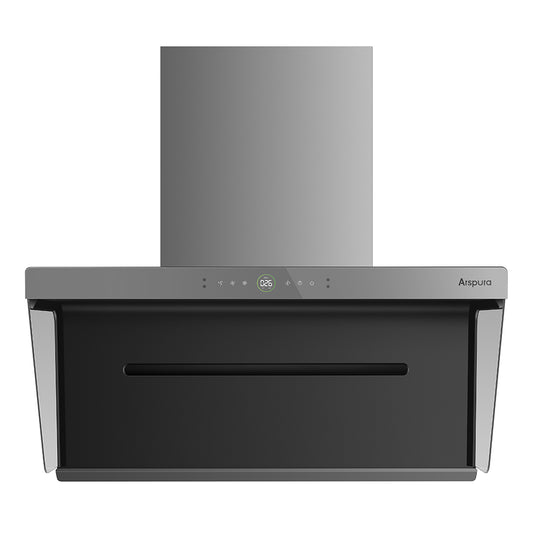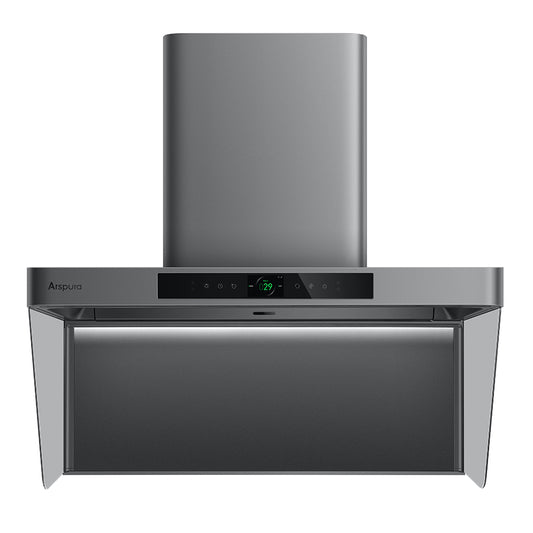Ducted vs. Ductless Range Hoods: Which One is Right
When planning a kitchen upgrade, one of the most important decisions you’ll face is whether to choose a ducted or ductless range hood. While it may seem like a small detail, the type of ventilation system you install can dramatically affect your cooking environment, indoor air quality, and even the long-term value of your home.
A well-designed range hood not only removes smoke, grease, and odors but also helps maintain a cleaner and more comfortable kitchen. With two primary choices to choose from, ducted and ductless, it's important to know how each system works and which one would work best for your cooking habits and kitchen layout.
In this ultimate guide, we'll take you through everything you need to know about ducted vs. ductless range hoods. You'll learn about their pros and cons, get a side-by-side comparison and get practical advice to help you choose the right solution.
At Arspura, we engineer ducted range hoods that are filled with innovation and good practicality. Whether you are looking for powerful and professional-grade ventilation or something that is flexible and easy to install, Arspura has a range hood to suit your kitchen's unique needs.
What is a Ducted Range Hood?
A ducted range hood or a vented hood is a form of ventilation that pulls air out of your cooktop area and out of your home through ductwork. This type of system works by using fans to draw in particles which are in the air, grease, smoke, and cook smell and expels them outdoors instead of recirculating them into the room.
Ducted hoods are particularly popular in larger homes, professional kitchens and for serious cooks, who create a lot of smoke or steam during cooking. They are normally installed above your stove and are connected to ductwork going outside, either into the ceiling, wall or roof.
How Does a Ducted Range Hood Work?
Air Capture: The canopy of the range hood covers your cooking surface and captures rising air.
Filtration: Grease filters (usually metal mesh or baffle filters) trap oil particles.
Exhaust: A fan system pushes smoke, odors, and heat through ducts that lead outside.
Complete Removal: Unlike ductless models, no contaminated air is recirculated back into your kitchen.
This makes ducted systems particularly effective at keeping your kitchen cooler, fresher, and free of lingering smells.
Pros of a Ducted Range Hood
Superior Air Quality
Pollutants, grease, and odors are completely removed, not recirculated.
Best for Heavy Cooking
Ideal for frying, grilling, and high-heat cooking methods that produce lots of smoke and grease.
Quieter Operation
Because air is vented outside, ducted hoods often operate more quietly than ductless models at similar power levels.
Higher Efficiency
Provides consistent airflow without the need for frequent filter replacements.
Boosts Home Value
A professionally installed ducted hood is often seen as a premium kitchen feature.
Cons of a Ducted Range Hood
Complex Installation: Requires ductwork through walls, ceilings, or roofs, which can be costly and labor-intensive.
Less Flexible Placement: Your cooktop location is limited by the ability to install ducting.
Higher Upfront Cost: Both the appliance and installation costs are generally higher than ductless models.
What is a Ductless Range Hood?
A ductless range hood, also called a recirculating range hood, filters air and then recirculates it back into the kitchen instead of venting it outdoors. These models use charcoal or carbon filters to catch odors and impurities and grease filters to catch oil particles.
They are especially popular in apartments, condos, or kitchens where ductwork is not feasible. A ductless hood offers more flexibility in installation and is often easier and quicker to set up.
Benefits of Ductless Range Hoods
-
Easy Installation: No ductwork required, making them ideal for renters or DIY installations.
-
Lower Cost: Both the appliance and installation costs are generally lower.
-
Flexible Placement: Can be installed almost anywhere, regardless of kitchen layout.
-
Portable Option: Easy to uninstall and move if you relocate.
- Energy Efficient in Cold Climates: Doesn’t pull heated indoor air outside, which helps maintain room temperature in winter.
Disadvantages of Ductless Range Hoods
Weaker Performance
Doesn’t remove air from the home; instead, it filters and recirculates it.
Frequent Filter Replacement
Charcoal filters need replacement every 3–6 months, adding to long-term costs.
Not Suitable for Heavy Cooking
If you frequently deep-fry, grill, or cook spicy foods, odors may linger.
Less Effective Against Moisture
Steam from boiling or simmering is not vented outside, which can increase kitchen humidity.
What Are the Differences Between Ducted and Ductless Range Hoods?
At first glance, ducted and ductless hoods may look similar, but their functionality and performance are quite different.
Key Differences:
Airflow Direction: Ducted hoods expel air outdoors; ductless hoods recirculate it inside.
Performance: Ducted hoods are stronger at removing odors, smoke, and humidity.
Installation: Ducted requires construction work; ductless does not.
Maintenance: Ductless requires frequent filter replacements; ducted needs occasional duct cleaning.
Cost: Ductless is cheaper upfront, but ducted may save more long-term in performance.
Comparison Table
| Feature | Ducted Range Hood | Ductless Range Hood |
|---|---|---|
| Airflow | Vents outside | Recirculates indoors |
| Odor Removal | Excellent | Moderate |
| Smoke & Grease Removal | Superior | Limited |
| Moisture Control | Yes | No |
| Installation | Complex, requires ductwork | Simple, plug-and-play |
| Maintenance | Duct cleaning | Filter replacement every 3–6 months |
| Best For | Heavy cooking, large kitchens | Light cooking, apartments |
| Cost | Higher | Lower |
Cost Breakdown: Ducted vs. Ductless Installation & Maintenance
Choosing a ducted or ductless range hood isn't simply a matter of function, but a matter of money—both short-term and long-term.
Upfront Costs: Why Ducted Hoods Are More Expensive
Ducted Systems: Ducted systems often require professional installation. This means cutting holes in walls or ceilings for ductwork and you may even need to hire a carpenter or roofer which can add hundreds or even thousands of dollars to your total cost.
Complex Materials: You'll have to buy duct pipes, vent caps and other specific parts for the exhaust system.
Long-Term Costs: The Trade-Off
Ducted Hoods (Lower Long-Term Cost): These systems have minimal ongoing expenses. You'll only need to clean the reusable metal grease filters and pay for the electricity to run the fan.
Ductless Hoods (Higher Long-Term Cost): They are cheaper to install but come with a recurring expense. They rely on charcoal filters to trap odors and particles, which must be replaced regularly—typically every few months. This recurring cost can add up significantly over the life of the unit.
Understanding Airflow and CFM: The Science Behind Range Hood Performance
Many people get the wrong idea and think that if the machine has a higher CFM (Cubic Feet per Minute) rating, it's good. While CFM is a measurement of the volume of air a fan can move, it doesn't give the full story. The real thing behind getting rid of cooking fumes is the air velocity, the capture velocity right over your stovetop.
Here is a breakdown of how it works:
The Problem with Traditional Hoods Older range hoods have a wide-open face design that allows for a weak, slow airflow (just 3-5 meters per second). This low velocity is not efficient at trapping tiny pollutants and odors and they can escape into your kitchen.
The Inefficiency of "Big Air" Simply increasing the CFM in these traditional designs can be counterproductive. A higher CFM can cause turbulent air which reduces the effectiveness of the hood to capture particles. This is why there are models with a high CFM number that you can feel powerful at first and then within a short time, it loses suction.
What Really Matters: Arspura effective range hood doesn't just move a whole bunch of air, it generates a strong, concentrated airflow at high speed that efficiently captures and removes all the pollutants, not just the visible smoke and steam. The idea is to be able to focus the suction where you want it most.
Legal and Building Code Considerations for Range Hood Installation
Before you start your project, it's crucial to understand the legal and building code requirements in your area. This is especially important for ducted systems, which involve structural modifications to your home.
Here's what you need to know:
Building Permits: Installing a ducted range hood may require a building permit to ensure the work meets local safety and ventilation standards. Failing to get one could lead to fines or even force you to remove the installation.
Local codes often dictate specific requirements for things like:
Duct material (e.g., rigid metal vs. flexible plastic)
Duct diameter to ensure proper airflow
Proper location for the vent exit to prevent backdrafting
Safety First: Adhering to these codes is not just about compliance; it's about safety. Improper installation can lead to serious hazards like fire risks or carbon monoxide buildup. While ductless hoods are generally less regulated, always check local guidelines to be safe.
Find The Best Ducted Range Hood With Arspura
Choosing between ducted and ductless range hoods comes down to your lifestyle, space, and priorities. If you’re after professional-grade air purification, ducted is the way to go. If you prefer flexibility and affordability, ductless may suit you best.
At Arspura, we specialize in advanced ducted range hoods that combine sleek design, whisper-quiet operation, and powerful airflow. Our hoods are built to handle the demands of everyday cooking as well as professional-style techniques, ensuring your kitchen stays fresh, clean, and comfortable.
If you want a range hood that goes beyond filtering air and delivers true ventilation performance, Arspura ducted range hoods are the ideal choice for your home.
Common Questions About Range Hoods
How loud are range hoods?
Noise levels vary, but most modern hoods, like those from Arspura, are engineered for whisper-quiet performance, even at higher speeds.
What size range hood do I need?
Ideally, your range hood should be at least as wide as your cooktop. For gas stoves or heavy cooking, choose a slightly wider hood for better coverage.
Do I need a professional to install a range hood?
For ducted hoods, professional installation is recommended due to ductwork complexity. Ductless hoods, however, can often be installed more easily.
Can a ductless range hood be converted to a ducted one?
Some models are convertible. You’ll need a compatible ducting kit and professional installation. Always check the manufacturer’s specifications before buying.
What is CFM and airflow speed, and why does airflow speed matter?
CFM measures how much air a range hood moves, but it doesn’t equal suction power. The real deciding factor is airflow speed, especially right above the cooktop. If the speed is too low—like many traditional hoods at only 3–5 m/s—smoke and fine particles escape into the kitchen.
Arspura ducted range hoods maintain high capture velocity at the source, ensuring grease, smoke, and odors are removed effectively without performance drop-off.






